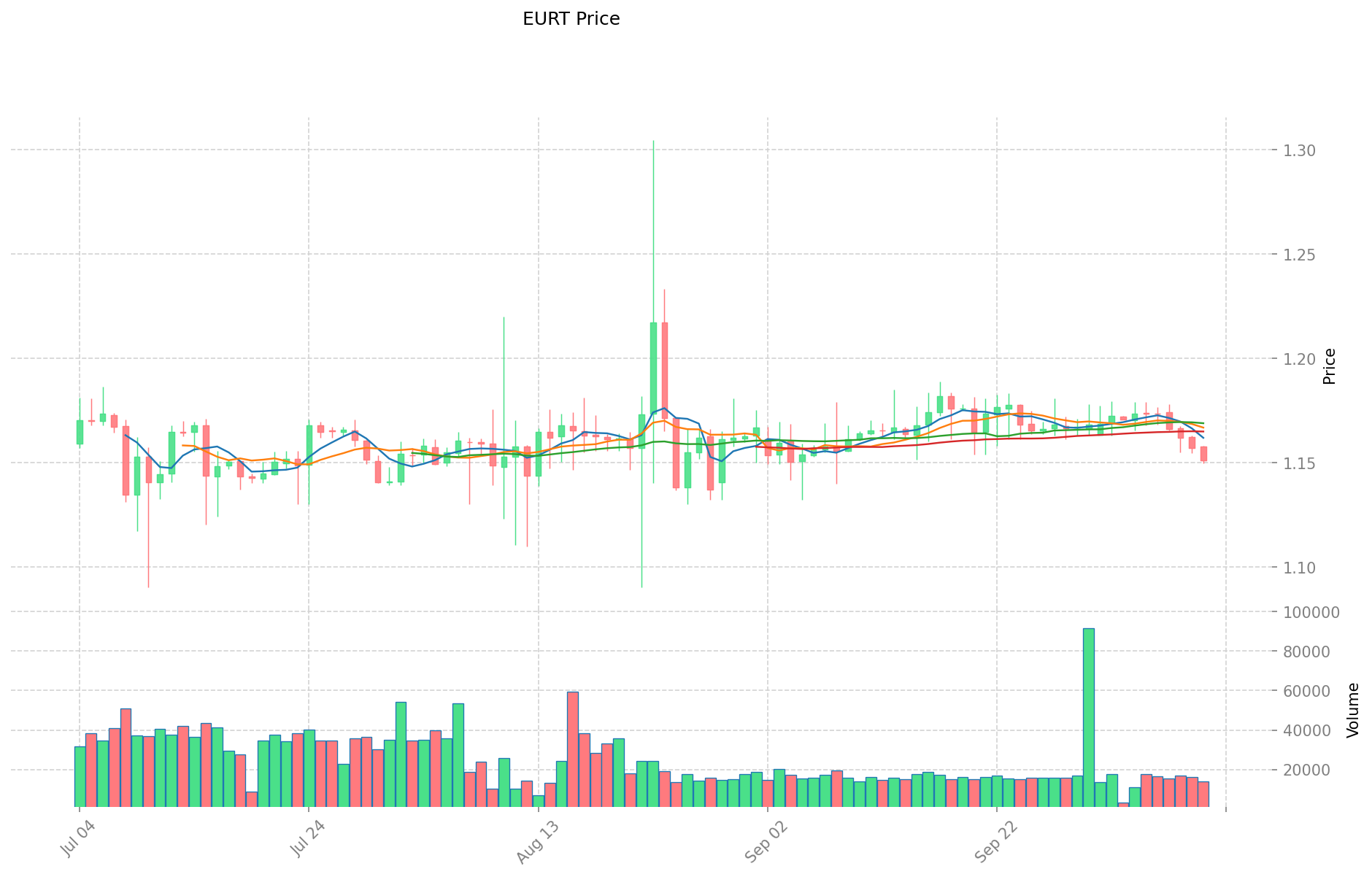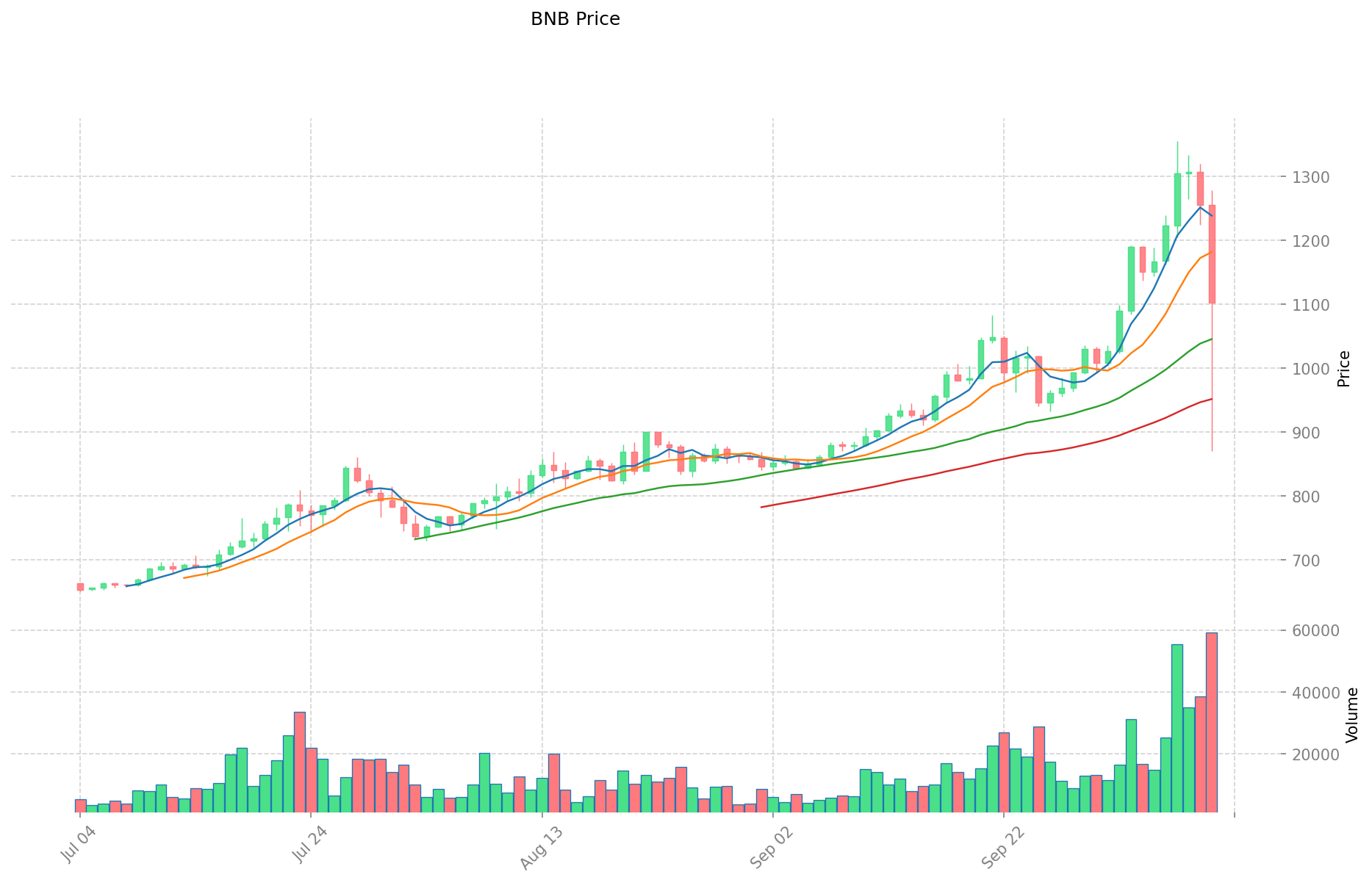EURT vs BNB: The Battle of Stablecoins in the Crypto Market
Introduction: EURT vs BNB Investment Comparison
In the cryptocurrency market, Euro Tether (EURT) vs Binance Coin (BNB) comparison has always been a topic that investors cannot avoid. The two not only have significant differences in market cap ranking, application scenarios, and price performance, but also represent different cryptocurrency asset positions.
Euro Tether (EURT): Since its launch, it has gained market recognition for its stable value pegged to the euro.
Binance Coin (BNB): Since its inception in 2017, it has been hailed as the "fuel of the Binance ecosystem" and is one of the cryptocurrencies with the highest global trading volume and market capitalization.
This article will comprehensively analyze the investment value comparison between EURT and BNB, focusing on historical price trends, supply mechanisms, institutional adoption, technological ecosystems, and future predictions, and attempt to answer the question that investors care about most:
"Which is the better buy right now?"
I. Price History Comparison and Current Market Status
EURT and BNB Historical Price Trends
- 2021: EURT maintained relative stability as a euro-pegged stablecoin.
- 2021: BNB surged to an all-time high of $1,330.51 due to the growth of Binance ecosystem.
- Comparative analysis: During market cycles, EURT has shown low volatility as expected for a stablecoin, while BNB has experienced significant price swings typical of major cryptocurrencies.
Current Market Situation (2025-10-11)
- EURT current price: $1.1519
- BNB current price: $1110.6
- 24-hour trading volume: $15,844.92 (EURT) vs $71,256,114.49 (BNB)
- Market Sentiment Index (Fear & Greed Index): 27 (Fear)
Click to view real-time prices:
- View EURT current price Market Price
- View BNB current price Market Price


Investment Value Analysis: BNB
I. Core Factors Affecting BNB's Investment Value
Supply Mechanism (Tokenomics)
- BNB: Deflationary model with regular burning mechanisms including quarterly burns and BEP-95 real-time burning that continuously reduce supply
- Supply reduction: Burns occur automatically with each transaction on BNB Smart Chain, creating dynamic reduction in circulation
- 📌 Historical pattern: BNB's value has been supported by its systematic burning events which create increasing scarcity
Institutional Adoption and Market Applications
- Institutional holdings: Recent data shows increasing institutional interest, with companies like CEA Industries reporting BNB holdings worth approximately $585.5 million
- Enterprise adoption: BNB serves as the core asset across the entire Binance ecosystem, connecting various products and services
- Regulatory stance: Regulatory approaches vary by jurisdiction, with BNB's value closely tied to Binance's regulatory standing globally
Technical Development and Ecosystem Building
- BNB Chain ecosystem: Functions as the native gas token for BNB Chain (including BSC and Beacon Chain), supporting transactions across thousands of DApps
- Technical compatibility: Full EVM compatibility allows developers to easily migrate applications from Ethereum to BNB Chain
- Ecosystem comparison: Extensive applications across DeFi, NFT, GameFi, and payment systems, with BSC becoming a major blockchain ecosystem
Macroeconomic Factors and Market Cycles
- Performance during market volatility: BNB has demonstrated favorable risk-return characteristics with higher Sharpe ratios and lower maximum drawdowns compared to other major cryptocurrencies
- Monetary policy impact: BNB price movements correlate with broader crypto market trends influenced by USD strength, interest rates and inflation data
- Market competition: Direct competition from other blockchain platforms like Solana, Avalanche, and exchange tokens like OKB may affect market demand
II. Investment Outlook
Current Market Position
- Market capitalization: Recently reached historical highs around $1,236.74, with market cap exceeding $175 billion, surpassing Solana and approaching Tether and XRP
- Trading volume: 24-hour trading volume has seen significant increases, with reports of a 37.3% surge to $3.31 billion during recent price rallies
- Historical performance: BNB has shown strong historical growth, with projections suggesting potential for continued appreciation
Risk Assessment
- Exchange dependency: BNB's value remains closely tied to Binance's operational success and regulatory standing
- Competitive threats: Emerging blockchain platforms could potentially divert market demand
- Market correlation: Tends to follow broader cryptocurrency market trends, particularly Bitcoin and Ethereum
III. 2025-2030 Price Prediction: EURT vs BNB
Short-term Prediction (2025)
- EURT: Conservative $0.68 - $1.15 | Optimistic $1.15 - $1.64
- BNB: Conservative $739.93 - $1121.10 | Optimistic $1121.10 - $1334.11
Mid-term Prediction (2027)
- EURT may enter a growth phase, with expected prices ranging from $1.24 to $2.06
- BNB may enter a volatile phase, with expected prices ranging from $732.51 to $1451.46
- Key drivers: Institutional capital inflow, ETF, ecosystem development
Long-term Prediction (2030)
- EURT: Base scenario $1.11 - $1.89 | Optimistic scenario $1.89 - $2.68
- BNB: Base scenario $1645.45 - $1808.19 | Optimistic scenario $1808.19 - $2676.12
Disclaimer
EURT:
| 年份 | 预测最高价 | 预测平均价格 | 预测最低价 | 涨跌幅 |
|---|---|---|---|---|
| 2025 | 1.635414 | 1.1517 | 0.679503 | 0 |
| 2026 | 1.49110599 | 1.393557 | 0.91974762 | 20 |
| 2027 | 2.06253403785 | 1.442331495 | 1.2404050857 | 25 |
| 2028 | 1.91015171540325 | 1.752432766425 | 1.20917860883325 | 52 |
| 2029 | 1.941169775368972 | 1.831292240914125 | 1.684788861640995 | 58 |
| 2030 | 2.678448031560999 | 1.886231008141548 | 1.112876294803513 | 63 |
BNB:
| 年份 | 预测最高价 | 预测平均价格 | 预测最低价 | 涨跌幅 |
|---|---|---|---|---|
| 2025 | 1334.109 | 1121.1 | 739.926 | 0 |
| 2026 | 1485.401445 | 1227.6045 | 1043.463825 | 10 |
| 2027 | 1451.458180575 | 1356.5029725 | 732.51160515 | 22 |
| 2028 | 2007.692224448625 | 1403.9805765375 | 1165.303878526125 | 26 |
| 2029 | 1910.53676855223 | 1705.8364004930625 | 1620.544580468409375 | 53 |
| 2030 | 2676.11614509351645 | 1808.18658452264625 | 1645.449791915608087 | 62 |
IV. Investment Strategy Comparison: EURT vs BNB
Long-term vs Short-term Investment Strategy
- EURT: Suitable for investors seeking stability and euro-pegged assets
- BNB: Suitable for investors interested in ecosystem growth and DeFi potential
Risk Management and Asset Allocation
- Conservative investors: EURT: 70% vs BNB: 30%
- Aggressive investors: EURT: 30% vs BNB: 70%
- Hedging tools: Stablecoin allocation, options, cross-currency portfolios
V. Potential Risk Comparison
Market Risk
- EURT: Exchange rate fluctuations between EUR and other currencies
- BNB: High volatility and correlation with overall crypto market trends
Technical Risk
- EURT: Centralization, reliance on issuer's reserves
- BNB: Scalability, network stability, potential smart contract vulnerabilities
Regulatory Risk
- Global regulatory policies may impact both assets differently, with EURT facing stablecoin regulations and BNB affected by exchange token scrutiny
VI. Conclusion: Which Is the Better Buy?
📌 Investment Value Summary:
- EURT advantages: Stability, euro exposure, potential hedge against USD volatility
- BNB advantages: Ecosystem growth, deflationary mechanism, high liquidity
✅ Investment Advice:
- New investors: Consider a balanced approach with higher EURT allocation for stability
- Experienced investors: Explore BNB's ecosystem potential while maintaining EURT for risk management
- Institutional investors: Evaluate BNB for long-term ecosystem growth, use EURT for treasury management
⚠️ Risk Warning: Cryptocurrency markets are highly volatile. This article does not constitute investment advice. None
VII. FAQ
Q1: What are the main differences between EURT and BNB? A: EURT is a euro-pegged stablecoin offering price stability, while BNB is a utility token for the Binance ecosystem with higher volatility and growth potential.
Q2: How does the supply mechanism differ between EURT and BNB? A: EURT's supply is backed by euro reserves, while BNB has a deflationary model with regular burning mechanisms that reduce its supply over time.
Q3: Which asset is better for short-term vs. long-term investment? A: EURT is better for short-term stability and as a euro hedge, while BNB may be more suitable for long-term growth potential tied to the Binance ecosystem's expansion.
Q4: What are the key risks associated with investing in EURT and BNB? A: EURT faces risks related to reserve backing and euro fluctuations, while BNB is exposed to high market volatility, regulatory scrutiny, and dependence on Binance's success.
Q5: How do institutional adoptions compare between EURT and BNB? A: BNB has seen increasing institutional interest, with companies reporting significant holdings, while EURT's institutional adoption is primarily for euro-denominated transactions and hedging.
Q6: What factors should be considered when allocating investments between EURT and BNB? A: Consider your risk tolerance, investment timeline, belief in the Binance ecosystem's growth, need for stability, and overall portfolio diversification strategy.
Q7: How might future regulatory changes affect EURT and BNB differently? A: EURT may face stablecoin-specific regulations, while BNB could be impacted by broader cryptocurrency exchange regulations and potential scrutiny of exchange tokens.
Share
Content